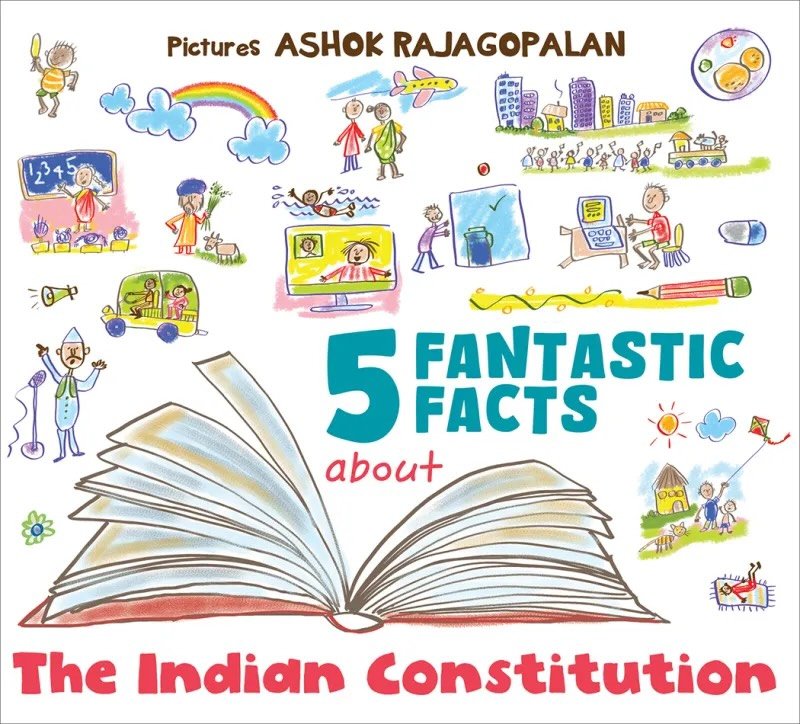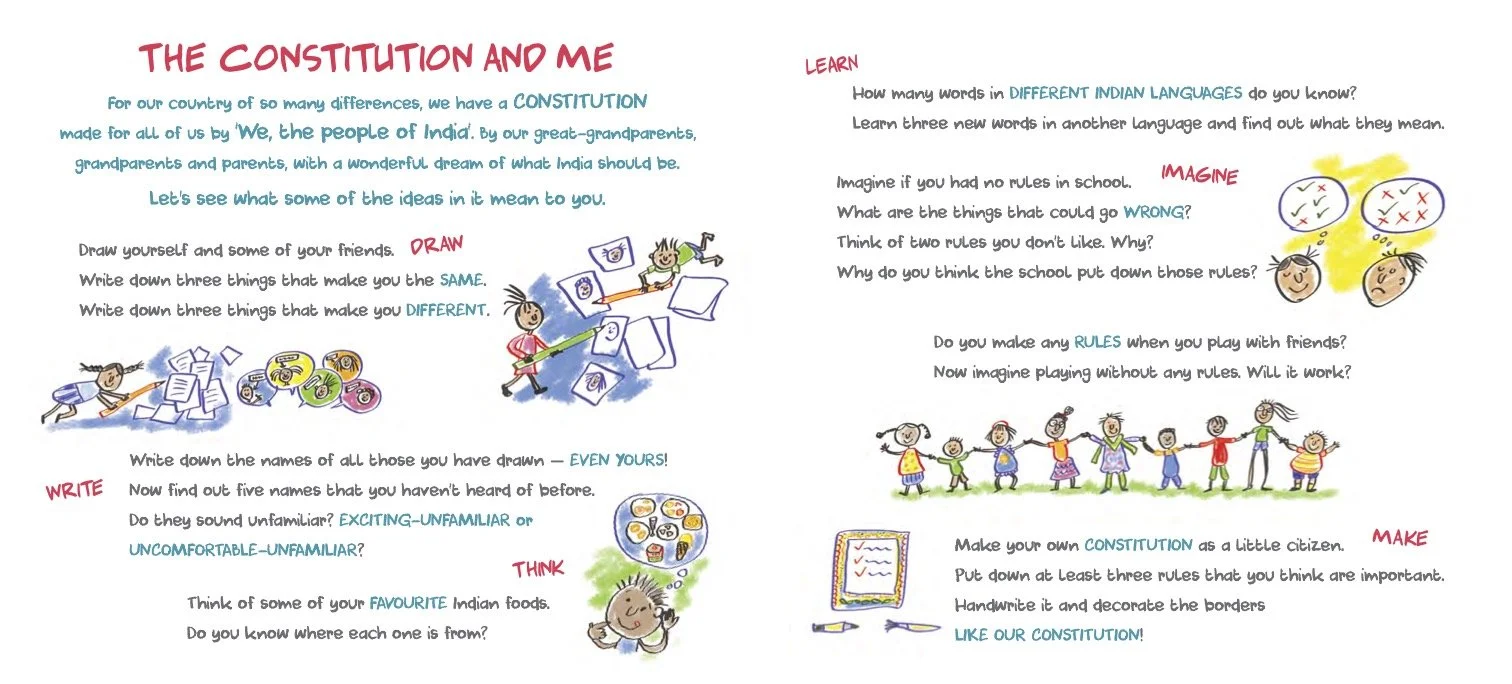Rules, Rights, and Duties: the World’s Longest Constitution Distilled for Kids
Understanding the law is an essential part of being an informed citizen, and constitutions codify the fundamental framework for a nation’s laws. What we’re finding out in this 21st century is that that democracies, by virtue of their inclusive, participatory processes, make it possible for aspiring authoritarians to attain power. They may even come into office through the very elections that symbolize open, democratic societies. And one of the first things that wannabe dictators aim to shackle or distort or bend to their own purpose is that country’s constitution.
So it makes a ton of sense to tell the children who live in democratic countries as much as we can about the constitution governing their country’s laws. How else can we ensure that they will stand to inherit a democracy? We’re learning in our time that the survival of democracies cannot be taken for granted.
The Indian constitution, it turns out, is a marvellous creation—the world’s longest, developed through a remarkable process of consultation and consensus. And here at last is a children’s book worthy of its breadth, depth, and its effort to reach into a just and equitable future.
From its mango-yellow endpapers with letters scribbled across them in multiple Indian language scripts to its freshly voiced text and the colourful, energetic illustrations by Ashok Rajagopalan, 5 Fantastic Facts About the Indian Constitution is a welcome invitation to young readers from Tulika Books.
I emailed Radhika Menon about the book and this is what she wrote:
It really was a challenge to do a picture book on the Constitution for five and six year olds as their first introduction to the Constitution. We, the editorial team, saw this as a very important book to have our children read. They should grow up with the knowledge that we have a fantastic constitution…and why it is fantastic. The idea had to be introduced visually with humour and affection for it to stay with them. Ashok was the perfect illustrator.
I had more questions. Here they are along with replies that reflect the opinions of the editorial team at Tulika:
Q: I see there’s no single author byline so I assume this book was written in-house by the writing talent you have on your editorial team. Can you say much more about the process by which this text was written?
A: Yes the writing was a collective effort by the editorial team. It was based on the video by actor Swara Bhaskar which she released in 2019 on Republic Day called 5 Cool Things You Did Not Know About The Indian Constitution. It was the video with Swara’s the simple, direct approach and conversational style that sparked off the idea for a book. Specifically a picture book introducing the Constitution to very young children.
The main problem was paring down the text - as everyone had opinions about what we should add, explain and so on. All with good reason. But the idea was to keep it minimal for this age group. And also have visuals that illustrated the fact. That was tough – much more than we thought. One reason was that it tended to get repetitive as it was about multitudes of people – over and over again. Ashok came up with the perfect style. We went through several illustrators and either they gave up or we did!
Q: I'm interested in that process because I find the voice in this book to be engaging and deceptively simple. It’s conversational yet informative. It’s never stodgy. It never talks down to the young reader. It is of course well edited for clarity and consistency but it’s got a real sparkle to it. Passages like the one that describes universal adult franchise, for example:
Or the pages that explain the nature of diversity.
I’d love you to unpack how your text was planned, written, and made whole.
A: We editors are pretty good at this—I include myself 😊—and very attuned to this kind of tone. I think it comes from years of tuning our ears to picture book texts, even the ones with serious themes and those with a more didactic slant! It's amazing how just changing a word or two, or rearranging lines, can suddenly give a text lightness—even a bit of sparkle!
After the illustrations were done we had to edit/rewrite text to go with it so that text and illustrations together conveyed the facts.
Q: This text is so simple: "Everyone has their own way of doing things…” and it sets up material, cultural, religious diversity elegantly through the illustrations. What did this look like on the before the illustrations were added?
A: This book particularly had many versions of text and illustrations and text with illustrations! That text was what we gave him. And we suggested this kind of layout based on what he sketched. The biggest challenge for the illustrator was to vary the pages and not make them repetitive given the text which talked of the multitudes and their ways of life, beliefs etc. throughout. Not easy but Ashok did a great job - and with humour which was so crucial.
Q: The final page walks the ideas behind the book right into the reader’s mind and thoughts. Talk about how you want young readers to engage with this section.
[A] I am so pleased you responded to these pages.
They needed a lot of thought. It was a challenge to make them feel light and breezy and not suddenly switched into workbook mode!
We didn’t intend to have this spread, but as we completed the book we realised it needed to speak to parents and teachers directly. Though the text addresses the child, it needs an adult to draw attention to the activities there. For this they had to see how the facts were relevant in their child’s everyday lives.
The idea of the activities is to make children pause and think of the things they take for granted - the names of their classmates, the food they eat, the languages they speak. (We have heard of just these factors sparking off fights and arguments in classrooms. More and more these days it seems. Very distressing.)
Q: Distressing but unsurprising. Is that why it made sense to frame the nation’s founding document as a big book of rules?
A: The idea is to think about rules and make the child see the need for rules. And make the connection to the biggest rule book they have been reading about in the book.
Q: It strikes me that the presentation here — beginning with the selection of 5 facts, all the way through to the end — relies on the airiness of the design. Can you tell me a little more about that?
A: We put a lot of thought into the book’s design—the choice of font, the colour palette—all of which needed to reflect the lightness of the text and highlight the humour in Ashok’s illustrations. While these are standard elements in book design, in a children’s book they make all the difference—between a serious, informational book and a fun, engaging one. The design conveys meaning as much as the text and illustration do.
This book is as packed with information as it’s fun and engaging. It’s just in time for August 15, India’s Independence Day (2 years, 11 months, and 18 days before January 26, 1950, the date on which the Indian Constitution went into effect).



